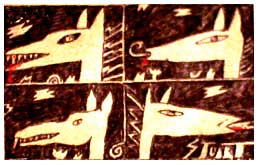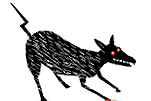In the rural areas
of Quezon province, animal bites,
most
commonly by dogs, cause considerable concern for rabies. Despite the
few hundred cases of rabies reported annually, traditional treatment
is usually not sought. Due to cost and economic constraints, and also
because of age-old myths and folklore, initial consultation is often
with the albularyo who will offer a variety of treatments from his
bag of folkloric remedies.
 Prior to treatment, the healer
may use diagnostic rituals to determine the presence of kamandag
or 'rabies.' The use of lunas is an
old diagnostic tool, but the paraphernalia is not commonly available.
Another ritual uses a strand of the patient's hair. The hair
is pulled firmly by both thumbs and index fingers, and passed
over the site of the bite. If the hair breaks, it is taken as
a sign that kamandag or 'rabies' is present. Prior to treatment, the healer
may use diagnostic rituals to determine the presence of kamandag
or 'rabies.' The use of lunas is an
old diagnostic tool, but the paraphernalia is not commonly available.
Another ritual uses a strand of the patient's hair. The hair
is pulled firmly by both thumbs and index fingers, and passed
over the site of the bite. If the hair breaks, it is taken as
a sign that kamandag or 'rabies' is present.
|
T R E A T M E N T S
|
Tapal at Bulong
 A tapal
is a piece of common materials (cloth or paper, ex: cigarette
rolling paper) to which a prayer has been written (orasyon) and
applied directly to the wound. The same prayer may also be whispered
(bulong) onto the applied material and wound. Another common
practice is to whisper the prayer on the top of the head hoping
to drive the poison back or downward, away from the brain. (The
framed letters on the left is an example of an 'orasyon' (written
prayer) applied to the wound, believed to be effective for the
treatment of a poisonous snake or rabid dog bite. E.S.D.M. is
a 'bibliato' for: emamil salvador del mundo.) A tapal
is a piece of common materials (cloth or paper, ex: cigarette
rolling paper) to which a prayer has been written (orasyon) and
applied directly to the wound. The same prayer may also be whispered
(bulong) onto the applied material and wound. Another common
practice is to whisper the prayer on the top of the head hoping
to drive the poison back or downward, away from the brain. (The
framed letters on the left is an example of an 'orasyon' (written
prayer) applied to the wound, believed to be effective for the
treatment of a poisonous snake or rabid dog bite. E.S.D.M. is
a 'bibliato' for: emamil salvador del mundo.)
|
Hihip at Bulong
Some healers prefer "hihip at bulong" as initial treatment.
The procedure consists of blowing wind through pursed lips to
the area of the animal bite alternating with short whispers of
prayers. The session lasts for about 15 to 20 minutes. Usually
one treatment suffices,
|
Lunas
Lunas is a material believed to be derived from a single-horned
animal or horn of a female deer. In the Bicol area, a similar
material is referred to as "tambal."
A small piece of this horn is applied directly to the wound.
It is believed the material will adhere to the wound only in
the presence of "kamandag" or rabies and will
fall off after a few hours when the 'kamandag' is no longer
present. After its use, because of uncommonness, the "horn"
is cleaned for future re-use by soaking in water where the kamandag
bubbles out of the lunas. It is not unusual for a 'tapal
with orasyon and/or bulong' to be performed after
the application of the lunas.
|
Kudlit
Kudlit refers to the practice of applying numerous
(as many as 30-100) superficial blade wounds distal to the site
of the bite causing bleeding that is believed to release the
"kamandag" (poison). Follow-up visits and treatments
are common, and even after a year and in the absence of any signs
or symptoms, if the arbularyo says that the 'kamandag'
is still present, most patients will readily consent to another
'kudlit' treatment.
See: Kudlit.html
|
Tapal ng Utak
If the animal - usually
a dog - is available, it is killed and the brain is applied to
the wound. In the past, it was not uncommon for the rest of the
dog to be cooked and consumed as a side dish (pulutan) to
alcoholic imbibition, a practice that has recently gone into
disfavor.
|









